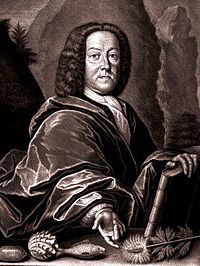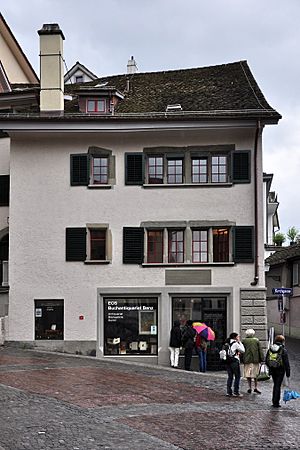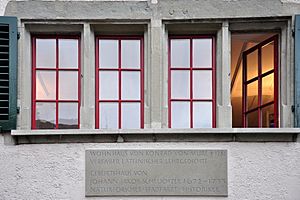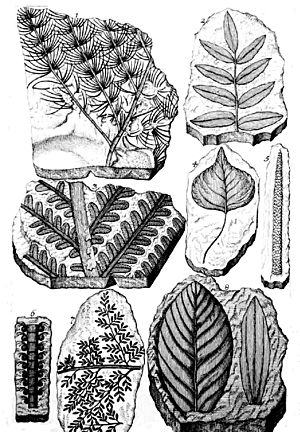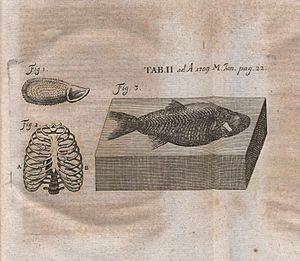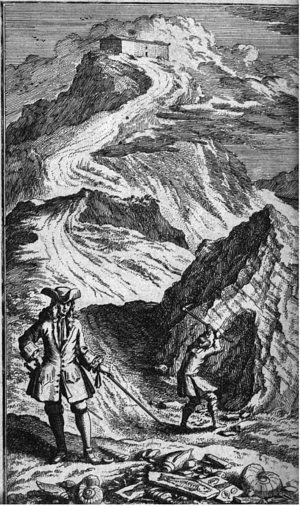Johann Jakob Scheuchzer facts for kids
Johann Jakob Scheuchzer (born August 2, 1672 – died June 23, 1733) was a Swiss scientist and scholar. He was born in Zürich, a city in Switzerland. Scheuchzer was known for his work in many fields, including medicine, mathematics, and natural history. He explored the Swiss Alps and studied the plants, animals, and rocks he found there.
Contents
A Young Scholar's Journey
Johann Jakob Scheuchzer was the son of a respected town physician in Zürich. He began his education in his hometown. In 1692, he moved to the University of Altdorf near Nuremberg to study medicine.
He earned his medical degree in early 1694 from the University of Utrecht. After this, he returned to Altdorf, Germany to continue his studies in mathematics.
Career and Achievements
In 1696, Scheuchzer came back to Zürich. He became a junior town physician. He was also promised a professorship in mathematics, which he received in 1710.
Later, in January 1733, he became a professor of physics and the senior city physician. Sadly, he passed away just a few months later, on June 23, 1733.
Scheuchzer's Published Works
Johann Jakob Scheuchzer wrote many books and articles during his lifetime. He published about 34 works, not counting his many shorter papers. Most of his historical writings are still in manuscript form, meaning they were never printed.
His most important published works were about his scientific observations and his travels. He collected a lot of information during his journeys, which he then used in his scientific books.
Exploring Swiss Nature
One of his major scientific works was Beschreibung der Naturgeschichte des Schweitzerlandes (Description of the Natural History of Switzerland). This book was published in three volumes between 1706 and 1708. The third volume included details about a journey he made in 1705.
Another important work was Helvetiae historia naturalis oder Naturhistorie des Schweitzerlandes (Natural History of Switzerland). This was published in three volumes from 1716 to 1718.
- The first part described the Swiss mountains. It gathered all the knowledge about them at that time.
- The second part focused on Swiss rivers, lakes, and mineral baths.
- The third part covered Swiss weather and geology (the study of Earth's physical structure).
Scheuchzer's books were very important. They were even used as a main source for Schiller's famous play Wilhelm Tell (1804). In 1704, Scheuchzer was elected a Fellow of the Royal Society, a prestigious scientific group in London. He also published many scientific notes in their journal, the Philosophical Transactions.
Adventures in the Alps
Scheuchzer also wrote about his travels. His book Itinera alpina tria (Three Alpine Journeys) was published in London in 1708. It described his trips from 1702 to 1704. This book was dedicated to the Royal Society. Famous scientists like Sir Isaac Newton helped pay for the illustrations in the book.
His most complete travel work, Itinera per Helvetiae alpinas regiones facta annis 1702–11, was published in 1723. It covered his journeys through the Swiss Alps from 1702 to 1711. These trips took him to almost every part of Switzerland, especially the central and eastern areas.
During his travels, he wrote about the Rhône Glacier and other Swiss glaciers. He also mentioned stories about dragons in Switzerland. While he doubted their existence, he included these reports and even some drawings of dragons. This has sometimes led people to misunderstand his work, but believing in dragons was common back then.
In 1712, Scheuchzer created a map of Switzerland. It was the best map of the country until the late 1700s. The eastern part of the map was especially accurate because it was based on his own observations.
Fossils and the "Human Witness"
Scheuchzer was also important for his work with fossils. In his book Lithographia Helvetica, he described fossils as "plays of nature" or as remains from the biblical Great Flood.
He famously claimed that a fossilized skeleton found in a quarry in Baden was the remains of a human who had died in the Great Flood. This idea seemed to support the stories in the Bible. Many people believed this for several decades after Scheuchzer's death.
However, in 1811, a French naturalist named Georges Cuvier re-examined the fossil. He showed that it was not a human at all, but actually a large prehistoric salamander!
Honours and Awards
In November 1703, Johann Jakob Scheuchzer was elected a Fellow of the Royal Society. This was a great honor for a scientist.
Today, some places and plants are named after him:
- Scheuchzerhorn (3462 m) and Scheuchzerjoch are mountains in the Bernese Alps.
- The plant family Scheuchzeriaceae and the plant species Scheuchzeria palustris are also named in his honor.
See also
 In Spanish: Johann Jakob Scheuchzer para niños
In Spanish: Johann Jakob Scheuchzer para niños


